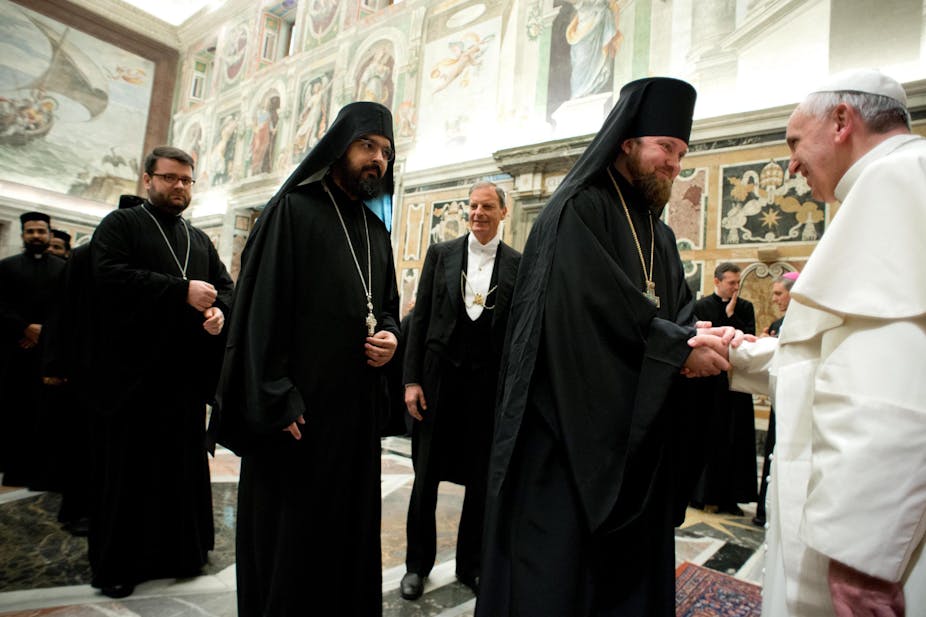Pope Francis announced this month he will visit the Middle East in May this year. While it has been foreshadowed since the first weeks of his papacy, this event will place the Church’s first South American Pope in the historic homeland of Christian faith, the “Holy Land”, which has witnessed a significant decrease in its Christian population in recent years.
Beyond the headlines, the long-term significance of the visit should be interpreted in light of the hope of unity between Christians.
Notably, Francis has referred to the “ecumenism of blood” in parts of the world where Christians have lost their lives for the sake of their faith (ecumenism refers to efforts to unite Christians). Francis has encouraged all Christians – not just Catholics – to pray for the gift of unity. In places where Christian numbers are dwindling, the Pope is urging churches to seek each other out in unity.
In this difficult context, His Holiness has identified one “principal goal” of his pilgrimage: to commemorate the 1964 meeting in Jerusalem between Pope Paul VI and Patriarch Athenagoras I of Constantinople (the head of the Eastern Orthodox Churches). In fact, the announcement of this new anniversary tour was made on January 5, 2014, 50 years to the day since the first meeting between leaders of the Roman Catholic and Eastern Orthodox Churches.

Pope Francis will meet with the Orthodox Patriarch, Bartholomew I at the site of the Holy Sepulchre, which Christians revere as the place of Jesus’ burial. The Bishop of Rome (Francis) will also visit Bethlehem, the birthplace of Christ, and Amman, Jordan, an important historical city for Christians, Jews and Muslims.
It should be remembered that the Great Schism – the split between the Eastern Orthodox and Roman Catholic Churches, which became official in the year 1054 – resulted in the Western and Eastern traditions of the Church continuing to develop largely in isolation from one another.
Out of the meeting in 1964 came the mutual rescinding of excommunications between the Roman Catholic and Eastern Orthodox Churches. Since then, neither Church has been in an official state of hostility or excommunication. For too long, the East and the West have been out of communion, and out of touch, but the new era, post 1964, has seen a renewed appreciation and attentiveness to one another.
By focusing his Holy Land pilgrimage on commemorating the meeting of his predecessor with the spiritual leader of the Eastern Orthodox Churches, Pope Francis is putting into effect the sentiments of a Common Declaration jointly published by the Pope and the Patriarch after the latter visited Rome in 1967. There, both emphasised not only a commitment to the restoration of unity, but stated that:
an essential element in the restoration of full communion between the Roman Catholic Church on the one side and the Orthodox Church on the other, is to be found within the framework of the renewal of the Church and of Christians in fidelity to the traditions of the Fathers and to the inspirations of the Holy Spirit Who remains always with the Church.
This was no mere rhetoric. Despite serious hiccups along the way, the dialogue between East and West was pursued by a previous Pope, John Paul II, in his implementation of the Second Vatican Council and, following a sad respite from its work, was officially re-instated by Francis’ predecessor, Pope Benedict XVI.

What Pope Francis has done is focus on Christian unity as a real and personal goal that will take place through a renewal of the Church’s mission.
That is to say, as the Church continually returns to its roots; in Scripture, in the traditions of the first millennium, in the enactment of its proclamation of the Gospel, in its appeal to God’s mercy for every human person, so also will the Church discover the means by which the East and the West will return to full and tangible unity.
Since his election in March last year, Pope Francis has embarked on a reform agenda that builds on the work of his immediate predecessors. There is a sense of renewed invigoration in the Catholic world that is, paradoxically perhaps, matched by the Pope’s popularity in the secular world, such as Time Magazine’s designation of Francis as Person of the Year.
Many have struggled to comprehend what the driving force is in this appreciation for Francis, a preacher who kisses the disabled, denounces exploitation of the poor, encourages us all to give to others, and not to stop when it hurts.
And perhaps that is the key: Pope Francis makes the Gospel a tangible, personal, face-to-face event. He wants to shake your hand, speak to each person in the room, tell every lost soul that God loves them. History –- and theology –- for Francis, is personal.
The Holy Land pilgrimage will be an opportunity to extend this personal approach. In seeking out Christian unity in the midst of the troubles of the Middle East, the signs are that Francis will make this more than a dialogue.
He will make it a personal relationship that helps to overcome the prejudices of history. It will be a large-scale echo of Francis’ famous embrace of Bartholomew I, the leader of the Eastern Orthodox Churches, at the Papal inauguration, during which Francis exclaimed “My brother Andrew”. Andrew was the brother of Peter, the first Bishop of Rome, and so the gesture was both symbolic and fraternal.
However it goes, and whatever other issues are dealt with, Pope Francis’ journey to the Middle East and the Holy Land will be a defining journey on the question of Catholic-Eastern Orthodox unity. Attentive eyes will recognise this; much of the world’s media will misunderstand its historic and its personal importance.

